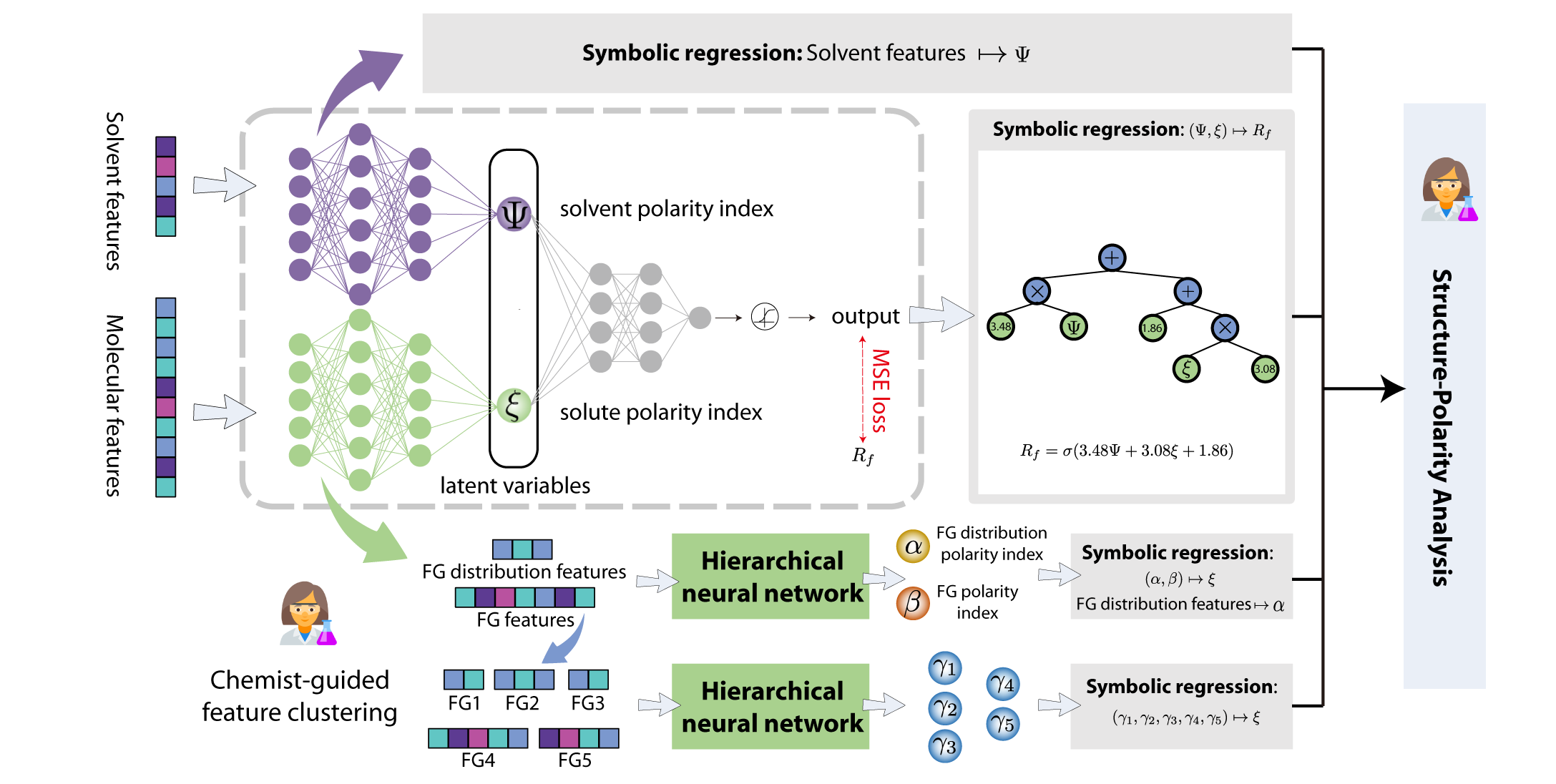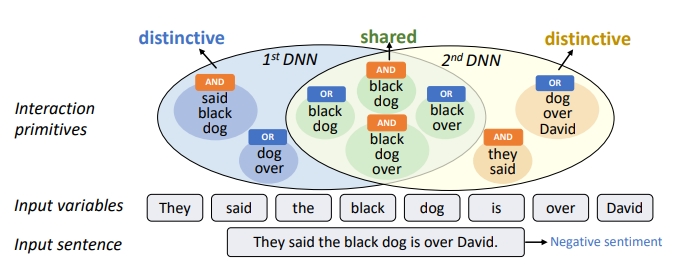Publications
here, * denotes equal contribution
2024
-
 Empowering Machines to Think Like Chemists: Unveiling Molecular Structure-Polarity Relationships with Hierarchical Symbolic RegressionSiyu Lou*, Chengchun Liu*, Yuntian Chen, and fanyang MoPreprint, 2024
Empowering Machines to Think Like Chemists: Unveiling Molecular Structure-Polarity Relationships with Hierarchical Symbolic RegressionSiyu Lou*, Chengchun Liu*, Yuntian Chen, and fanyang MoPreprint, 2024Thin-layer chromatography (TLC) is a crucial technique in molecular polarity analysis. Despite its importance, the interpretability of predictive models for TLC, especially those driven by artificial intelligence, remains a challenge. Current approaches, utilizing either high-dimensional molecular fingerprints or domain-knowledge-driven feature engineering, often face a dilemma between expressiveness and interpretability. To bridge this gap, we introduce Unsupervised Hierarchical Symbolic Regression (UHiSR), combining hierarchical neural networks and symbolic regression. UHiSR automatically distills chemical-intuitive polarity indices, and discovers interpretable equations that link molecular structure to chromatographic behavior.
-
 Defining and extracting generalizable interaction primitives from DNNsLu Chen*, Siyu Lou*, Benhao Huang, and Quanshi ZhangIn International Conference on Learning Representations, 2024
Defining and extracting generalizable interaction primitives from DNNsLu Chen*, Siyu Lou*, Benhao Huang, and Quanshi ZhangIn International Conference on Learning Representations, 2024Faithfully summarizing the knowledge encoded by a deep neural network (DNN) into a few symbolic primitive patterns without losing much information represents a core challenge in explainable AI. To this end, Ren et al. (2023) have derived a series of theorems to prove that the inference score of a DNN can be explained as a small set of interactions between input variables. However, the lack of generalization power makes it still hard to consider such interactions as faithful primitive patterns encoded by the DNN. Therefore, given different DNNs trained for the same task, we develop a new method to extract interactions that are shared by these DNNs. Experiments show that the extracted interactions can better reflect common knowledge shared by different DNNs.
2023
-
 HarsanyiNet: Computing Accurate Shapley Values in a Single Forward PropagationLu Chen*, Siyu Lou*, Keyan Zhang, Jin Huang, and Quanshi ZhangIn International Conference on Machine Learning, 2023
HarsanyiNet: Computing Accurate Shapley Values in a Single Forward PropagationLu Chen*, Siyu Lou*, Keyan Zhang, Jin Huang, and Quanshi ZhangIn International Conference on Machine Learning, 2023The Shapley value is widely regarded as a trustworthy attribution metric. However, when people use Shapley values to explain the attribution of input variables of a deep neural network (DNN), it usually requires a very high computational cost to approximate relatively accurate Shapley values in real-world applications. Therefore, we propose a novel network architecture, the HarsanyiNet, which makes inferences on the input sample and simultaneously computes the exact Shapley values of the input variables in a single forward propagation. The HarsanyiNet is designed on the theoretical foundation that the Shapley value can be reformulated as the redistribution of Harsanyi interactions encoded by the network.
-
 Bayesian Neural Networks Avoid Encoding Perturbation-sensitive and Complex ConceptsQihan Ren*, Huiqi Deng*, Yunuo Chen, Siyu Lou, and Quanshi ZhangIn International Conference on Machine Learning, 2023
Bayesian Neural Networks Avoid Encoding Perturbation-sensitive and Complex ConceptsQihan Ren*, Huiqi Deng*, Yunuo Chen, Siyu Lou, and Quanshi ZhangIn International Conference on Machine Learning, 2023In this paper, we focus on mean-field variational Bayesian Neural Networks (BNNs) and explore the representation capacity of such BNNs by investigating which types of concepts are less likely to be encoded by the BNN. It has been observed and studied that a relatively small set of interactive concepts usually emerge in the knowledge representation of a sufficiently-trained neural network, and such concepts can faithfully explain the network output. Based on this, our study proves that compared to standard deep neural networks (DNNs), it is less likely for BNNs to encode complex concepts. Experiments verify our theoretical proofs. Note that the tendency to encode less complex concepts does not necessarily imply weak representation power, considering that complex concepts exhibit low generalization power and high adversarial vulnerability.
2022
-
 Audio-text retrieval in contextSiyu Lou, Xuenan Xu, Mengyue Wu, and Kai YuIn IEEE International Conference on Acoustics, Speech and Signal Processing, 2022
Audio-text retrieval in contextSiyu Lou, Xuenan Xu, Mengyue Wu, and Kai YuIn IEEE International Conference on Acoustics, Speech and Signal Processing, 2022Audio-text retrieval based on natural language descriptions is a challenging task. It involves learning cross-modality alignments between long sequences under inadequate data conditions. In this work, we investigate several audio features as well as sequence aggregation methods for better audio-text alignment. Moreover, through a qualitative analysis we observe that semantic mapping is more important than temporal relations in contextual retrieval. Using pre-trained audio features and a descriptor-based aggregation method, we build our contextual audio-text retrieval system. Specifically, we utilize PANNs features pre-trained on a large sound event dataset and NetRVLAD pooling, which directly works with averaged descriptors. Experiments are conducted on the AudioCaps and CLOTHO datasets, and results are compared with the previous state-of-the-art system. With our proposed system, a significant improvement has been achieved on bidirectional audio-text retrieval, on all metrics including recall, median and mean rank
- Automatic Detection Pipeline for Accessing the Motor Severity of Parkinson’s Disease in Finger Tapping and Postural StabilityNing Yang, De-Feng Liu, Tao Liu, Tianyuan Han, Pingyue Zhang, Xuenan Xu, Siyu Lou, Huan-Guang Liu, An-Chao Yang, Cheng Dong, and othersIEEE Access, 2022
Parkinson’s disease (PD) is a nervous disorder that can cause motor impairment. PD severity assessment based on a series of motor movements illustrated in Unified Parkinson’s Disease Rating Scale (UPDRS) is an important part of clinical PD diagnosis. However, the current quantifying method heavily relies on human observation, which is time-consuming and subjective. Therefore, automatic severity estimation stemming from machine learning methods is receiving an increasing amount of research attention. However, these advances are still limited by data availability and interpretability. In this paper, we release a large PD motor dataset of over 300 real PD patients collected under doctors’ instructions and propose a pipeline to automatically quantify the motor severity of PD in finger tapping and postural stability. These two selected movements are representative of local and global motor control, exhibiting great clinical importance. The pipeline contains three-stage: pose estimation, domain knowledge extraction, and classification stage. The pose estimation uses deep-learning-based methods to extract 21 and 17 key points for finger tapping and postural stability respectively. The domain knowledge extraction stage extracts several explicit features pre-defined by experienced neuro-physicians. Finally, a classifier is trained to infer PD severity under MDS-UPDRS. To combine deep-learning-based features from pose estimation and domain features from the expert, the pipeline achieves a better trade-off between the model efficiency and clinical interpretability. Experiments show that our method achieves a micro average f1-score of 88%, 84%, and 84%, respectively on left finger tapping, right finger tapping, and postural stability, outperforming previous methods by a large margin. In addition, involving expert knowledge in the feature extraction stage greatly improves our model’s interpretability, which is essential in automatic PD detection.
2017
- materialsFast in situ 3D nanoimaging: a new tool for dynamic characterization in materials scienceJulie Villanova, Rémi Daudin, Pierre Lhuissier, David Jauffres, Siyu Lou, Christophe L Martin, Sylvain Labouré, Rémi Tucoulou, Gema Martı́nez-Criado, and Luc SalvoMaterials Today, 2017
The performance of many advanced materials is determined by the arrangement of their nanostructure which requires ever more precise characterization. In this respect, X-ray computed tomography (CT) is a powerful technique to investigate material properties as it provides non-destructive direct access to three-dimensional morphology with nanoscale resolution. However, challenges remain in clearly understanding physical mechanisms involved during their processing in real time and real conditions. So far, beam and sample stabilities, effective spatial resolution and tomography scan time have hindered the development of nanoscale in situ 4D imaging (3D plus time), and especially at high temperatures. Here, we report on the development of fast X-ray nanotomography at temperatures up to 700°C with an unprecedented combination of nanometer pixel size and acquisition times of a few tens of seconds. The great potential of the method is demonstrated by following the early stages of two thermally driven phenomena: neck curvature evolution in sintering and nucleation of liquid droplets in light alloys. The reported real time observations will benefit the fundamental understanding of the underlying physics and provide useful data to build new models. The novel aspects of this synchrotron based technique offer a powerful imaging tool for a wide variety of heterogeneous nanoscale dynamics in materials and open new perspectives for the investigation of advanced materials under realistic conditions.
2016
- materialsMicropore-induced capillarity enhances bone distribution in vivo in biphasic calcium phosphate scaffoldsLaurence E Rustom, Thomas Boudou, Siyu Lou, Isabelle Pignot-Paintrand, Brett W Nemke, Yan Lu, Mark D Markel, Catherine Picart, and Amy J Wagoner JohnsonActa biomaterialia, 2016
The increasing demand for bone repair solutions calls for the development of efficacious bone scaffolds. Biphasic calcium phosphate (BCP) scaffolds with both macropores and micropores (MP) have improved healing compared to those with macropores and no micropores (NMP), but the role of micropores is unclear. Here, we evaluate capillarity induced by micropores as a mechanism that can affect bone growth in vivo. Three groups of cylindrical scaffolds were implanted in pig mandibles for three weeks: MP were implanted either dry (MP-Dry), or after submersion in phosphate buffered saline, which fills pores with fluid and therefore suppresses micropore-induced capillarity (MP-Wet); NMP were implanted dry. The amount and distribution of bone in the scaffolds were quantified using micro-computed tomography. MP-Dry had a more homogeneous bone distribution than MP-Wet, although the average bone volume fraction, BVF, was not significantly different for these two groups (0.45±0.03 and 0.37±0.03, respectively). There was no significant difference in the radial bone distribution of NMP and MP-Wet, but the BVF of NMP was significantly lower among the three groups (0.25±0.02). These results suggest that micropore-induced capillarity enhances bone regeneration by improving the homogeneity of bone distribution in BCP scaffolds. The explicit design and use of capillarity in bone scaffolds may lead to more effective treatments of large and complex bone defects.